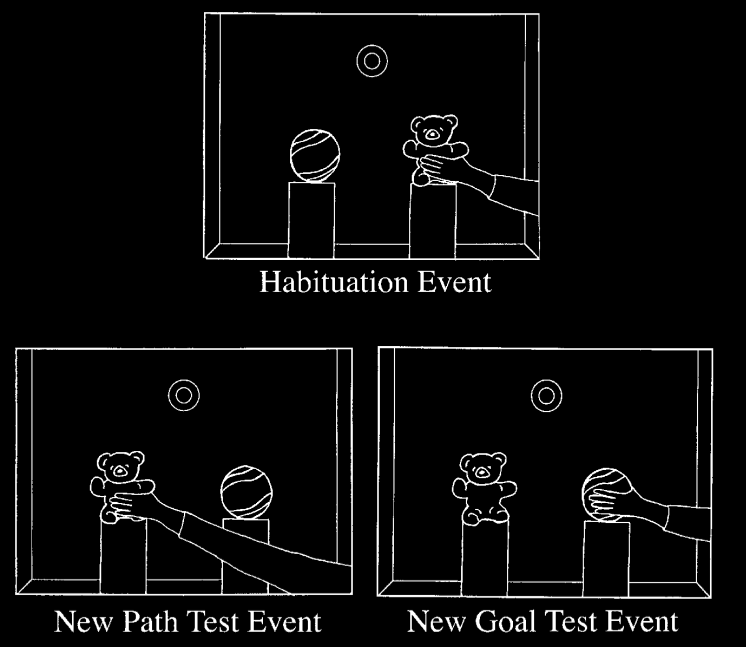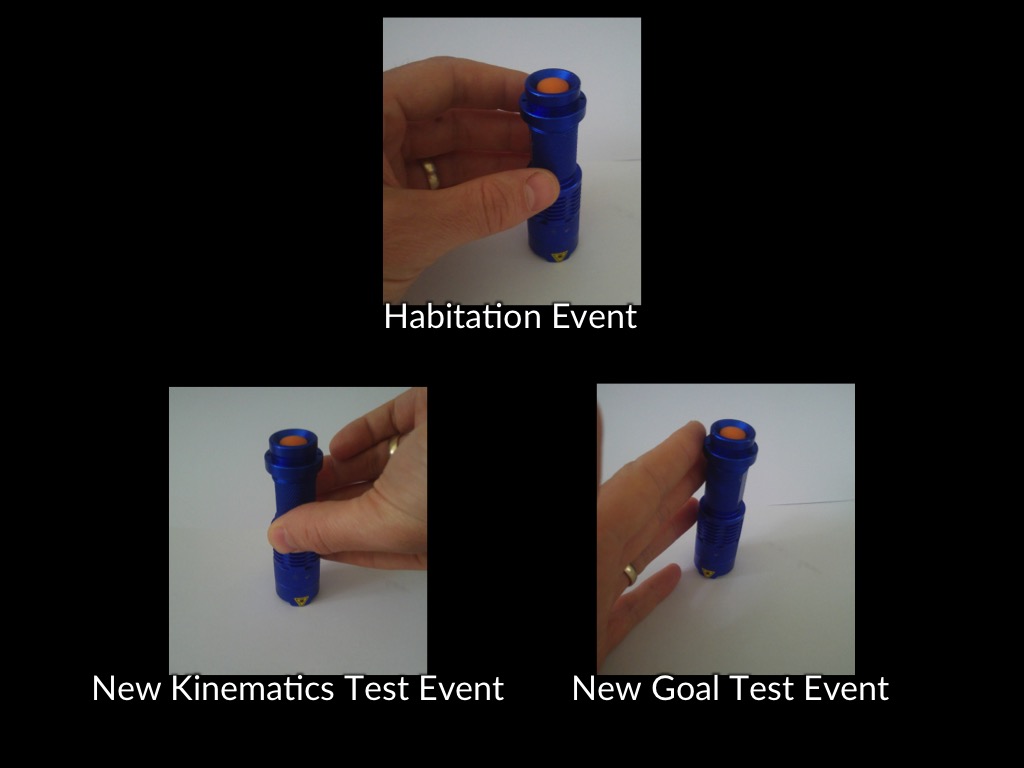Click here and press the right key for the next slide (or swipe left)
also ...
Press the left key to go backwards (or swipe right)
Press n to toggle whether notes are shown (or add '?notes' to the url before the #)
Press m or double tap to slide thumbnails (menu)
Press ? at any time to show the keyboard shortcuts
Action: When?
When?
When can infants first track goals to which actions are directed?
Consider a much-replicated study by Woodward and colleagues.

Woodward et al 2001, figure 1
'Six-month-olds and 9-month-olds showed a stronger novelty response (i.e., looked longer) on new-goal trials than on new-path trials (Woodward 1998). That is, like toddlers, young infants selectively attended to and remembered the features of the event that were relevant to the actor’s goal.'
\citep[p.\ 153]{woodward:2001_making}
When? From three nine months of age.
Using a manipulation we’ll discuss later (‘sticky mittens’),
\citet{sommerville:2005_action} used this paradigm to show that even
three-month-olds can form expectations based on the goal of an action
(for another study with three-month-olds, see also \citealp{luo:2011_threemonthold}).
... or maybe not
goal vs target
I distinguish {goals} from {targets}.
The \emph{target} or \emph{targets} of an action (if any) are the things the towards which it is directed.
If kicking a football is the goal of an action, the football is its target.
To specify a target of an action is to partially specify one of its goals.
But more is required to fully specify a goal, of course.

anatomy of a goal
A goal typically involves a type of action---kicking rather than smashing, say---as well as manners of
action---discretely, firmly, and precisely, for example---and perhaps more besides.
For a process to \emph{track} a target of an action is for how that process unfolds to nonaccidentally
depend in some way on whether that thing is indeed a target of the action.
The studies we have considered so far focus on infants’ abilities to track the targets of actions.

anatomy of a goal

anatomy of a goal

anatomy of a goal

anatomy of a goal
For a process to \emph{track} a target of an action is for how that process unfolds to nonaccidentally
depend in some way on whether that thing is indeed a target of the action.
The studies we have considered so far focus on infants’ abilities to track the targets of actions.
Given the liberal way I have defined tracking a goal, a process which tracks a target is thereby a process which tracks a goal. (The converse will often hold too, although there could be exceptions.)
It is conceivable that some types of processes \emph{merely} track targets: that is,
processes of this type only ever track goals in virtue of tracking targets.
The studies we have considered so far are consistent with the hypothesis that infants
are merely tracking targets in this sense.
Are infants under 10 months of age merely tracking targets?

To answer this question, we would ideally have pairs of scenarios in which the target of an action
is kept constant while the type of action varies.
To the extent that subjects respond appropriately to the difference in type of action, we can be
confident that they can distinguish actions not just by their targets but also by their types.
This is illustrated here, where you are habituated to a grasping event and the test events are
(a) grasping but with novel kinematics (from a different angle), or (b) a novel goal event (pushing).
Unfortunately, as far as I know this has not yet been done.
But there are some studies which, although not intended to get at exactly the issue of whether
infants track goals and not just targets of actions, do indirectly shed light on this issue.
These studies demonstrate competence in goal-tracking from nine months of age, and give us no reason
to doubt that, in simple enough cases, infants might show competence in goal tracking much earlier.
\citet{Behne:2005dw} created just such pairs of contrasting scenarios.
In one of their contrasts, an experimenter holds a ball out for an infant to grasp and then
either ‘accidentally’ drops it or teasingly pulls it back.
So in each case there is a goal-directed action involving the ball, but in one case the goal
of the action is to pass the ball to the infant whereas in the other case the goal is to
tease the infant.
\citet[Study 2]{Behne:2005dw} found that nine-month-olds (but not six-month-olds)
consistently and appropriately discriminated between these scenarios by, for example,
banging more when the ball was ‘accidentally’ dropped than when it was teasingly retracted.
This and other research
(e.g. \citealp{ambrosini:2013_looking}) suggests that, at least from nine months of age,
infants can indeed distinguish both the type and target of a goal-directed action.
% \citet{ambrosini:2013_looking} is important: shows that type of grasp and not just target is tracked, implying that anticipatory looking is not merely perceptual animacy.
Evidence from infants in the first nine months
| age (mnths) | target varies | type varies | manner varies | |
| Woodward et al, 2001 | 6 & 9 | ✓ | x | x |
| Behne et al, 2005 | 9 | x | ✓ | x |
| Ambrosini et al, 2013 | 6 & 9 | ✓ | ✓ | x |
How?
Infants can track goals from nine months of age (or earlier).
The question, of course, is how?